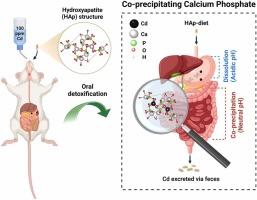Co-precipitating Calcium Phosphate as Oral Detoxification of Cadmium
IF 11.3
1区 环境科学与生态学
Q1 ENGINEERING, ENVIRONMENTAL
引用次数: 0
Abstract
Bone-eating (also known as osteophagia), found in wild animals, is primarily recognized as a means to supplement phosphorus and calcium intake. Herein, we describe a novel function of bone-eating in detoxifying heavy metal ions through the dissolution and co-precipitation of bone minerals as they travel through the gastrointestinal (GI) tract. In this study, cadmium (Cd), a heavy metal ion, served as a toxic model. We demonstrated that hydroxyapatite (HAp), the major calcium phosphate (CaP) in bone, dissolves in the stomach and acts as a co-precipitant in the intestine for Cd detoxification. We compared HAp to a common antidote, activated charcoal (AC), which did not precipitate within the GI tract. In vitro experiments showed that HAp dissolves under acidic conditions and, upon return to a neutral environment, efficiently re-sequesters Cd. Similarly, oral administration of HAp effectively prevented Cd absorption and accumulation, resulting in enhanced Cd excretion in the feces when compared to AC. A co-precipitating CaP in the GI tract could serve as an excellent detoxification system, as it helps prevent the accumulation of toxic substances and aids in developing appropriate strategies to reduce tissue toxicity. Moreover, understanding this detoxification system would be a valuable indicator for designing efficient detoxification materials.

共沉淀磷酸钙作为镉的口服解毒剂
在野生动物中发现的食骨(也称为噬骨),主要被认为是补充磷和钙摄入量的一种手段。在这里,我们描述了一种新的功能,即通过骨矿物质的溶解和共沉淀,通过胃肠道来解毒重金属离子。在本研究中,重金属离子镉(Cd)作为毒性模型。我们证明了羟基磷灰石(HAp),骨骼中主要的磷酸钙(CaP),在胃中溶解,并在肠道中作为Cd解毒的共同沉淀剂。我们将HAp与一种常见的解毒剂活性炭(AC)进行了比较,后者不会在胃肠道内沉淀。体外实验表明,HAp在酸性条件下可溶解,回到中性环境后,可有效地重新封存Cd。同样,与AC相比,口服HAp可有效地阻止Cd的吸收和积累,从而增加粪便中Cd的排泄。胃肠道中共同沉淀的CaP可作为一种良好的解毒系统。因为它有助于防止有毒物质的积累,并有助于制定适当的策略来减少组织毒性。此外,了解这种解毒系统将为设计有效的解毒材料提供有价值的指标。
本文章由计算机程序翻译,如有差异,请以英文原文为准。
求助全文
约1分钟内获得全文
求助全文
来源期刊

Journal of Hazardous Materials
工程技术-工程:环境
CiteScore
25.40
自引率
5.90%
发文量
3059
审稿时长
58 days
期刊介绍:
The Journal of Hazardous Materials serves as a global platform for promoting cutting-edge research in the field of Environmental Science and Engineering. Our publication features a wide range of articles, including full-length research papers, review articles, and perspectives, with the aim of enhancing our understanding of the dangers and risks associated with various materials concerning public health and the environment. It is important to note that the term "environmental contaminants" refers specifically to substances that pose hazardous effects through contamination, while excluding those that do not have such impacts on the environment or human health. Moreover, we emphasize the distinction between wastes and hazardous materials in order to provide further clarity on the scope of the journal. We have a keen interest in exploring specific compounds and microbial agents that have adverse effects on the environment.
 求助内容:
求助内容: 应助结果提醒方式:
应助结果提醒方式:


